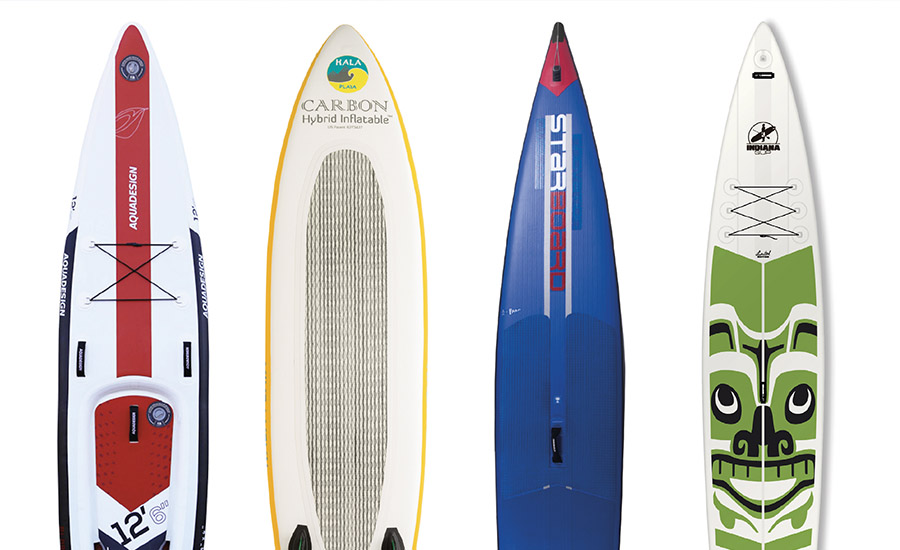As inflatables flood the market, designers are forced to come up with new innovations to truly set their boards and designs apart.
With the increase in performance and quality of inflatable materials, the influx of new inflatable designs is evident. In the 2017 PaddleSports Buyers Guide, we had to create an entire new SUP category to accommodate iSUPs. While there are inflatable boards for everything, almost every company is making what we call the “Inflatable Cruiser,” an inflatable all-around board designed for a little bit of everything. Typically, the Inflatable Cruiser is between 10’6-11’ long, 6” thick, and 28”-30” wide. They have subtly rounded noses, and offer great access to the outdoors, even for the recreational user. Many are aimed at a lower-end user who is looking for a product within a certain price point. With such similar specs and performance goals, how can companies distinguish themselves from the pack?
When facing the low-cost wave, brands have two options: follow the low-cost (and often, lower-quality) trend, or fight back with added value products and strong R&D.
“While inflatable boards can look similar,” says Peter Hall, owner and founder of Hala Gear SUP, “the manufacturer’s obvious and hidden choices are what make or break the board.” While some of the lower-end boards feature flashy graphics and can be fun, “these temptingly-
cheap boards often are made with lower-quality textiles, low-quality glue, lower-density Dropstitch and base cloth, and they lack the higher-performance components, shapes, rockers, and industry-leading tech that make the difference between a glorified pool toy and piece of equipment that will leave you questioning if you will ever buy a hard board again,” argues Hall.
Hall’s company Hala Gear SUP specializes in whitewater inflatables, though their range includes all disciplines. Their Stomp Box retractable fin system is a prime example of R&D and innovation that adds value and distinction to their brand. Designed for the variable river bottom and the inevitable rock, the Stomp Box is a spring-loaded fin that retreats into the board on impact. The Stomp box comes with many of Hala’s whitewater boards, and is offered as an upgrade on others.
It can be difficult to know if what companies tout as their distinguishing features are indicative
of true innovation and quality, or are mere gimmicks. “The amount of air pressure is not a good shortcut to understand the construction quality,” clarifies Hall. He recommends looking at warranties, use-specific rocker, unique board shapes, advanced fin options,
gear rigging options, and true stiffening technology as indicators of board quality.
On the whole, the pressure of a competitive market is paying off. Companies are finding ways to advance board stiffness and performance, furthering the divide between entry level and higher performance boards. The incorporation of other technologies into the inflatable
market is one clear indication of advancement. Red SUP’s Rocker Stiffening System utilizes flat carbon rods that slide into the rails, while Hala’s Carbon Nass-T, an inflatable raceboard is re-inforced with carbon construction, making it “three times as stiff.”
The BiDrop SUP from the French-based Aquadesign features two inflatable chambers for additional rigidity and lower stance position. By offering a lower stance position, the BiDrop allows for a higher level of stability without compromising performance and adds increased safety for offshore paddling.
Starboard SUP has sought to distinguish their SUPs in both appearance and performance. Their Tikihine Sun features fun, bright, ocean-inspired graphics by artist Sonni Honscheid. Their latest innovation involves the use of a free-flowing aramid cable in their All Star Airline SUPs as a sort of stringer technology. The cable, which is slightly shorter than the board, locks in place when the board is inflated; enhancing rigidity to create the sensation of a solid, trustworthy hull.
However, having a plethora of options and a wide range of entry-level boards can benefit
the industry. “Lower-priced boards do serve a purpose, and are vital for the growth of paddle boarding,” argues Svein Rasmussen, owner of Starboard SUP. The truth is, many individuals simply want a board that is affordable, practical, looks good, and gets them on the water. To accommodate this, many companies, like Indiana SUP, offer packages where the purchase of a board comes with a paddle, pump, bag, fins and leash.
The truth is, it shouldn’t be about the price, or the specific features. “It is all about creating value, trust and a desirable experience,” explains Rasmussen. “This trust and innovative quality will in turn result in higher second hand pricing, better performance and proper after sales service.”
By: Anna Bruno, Kayak Session, Paddle World and Sup World Mag editor.


